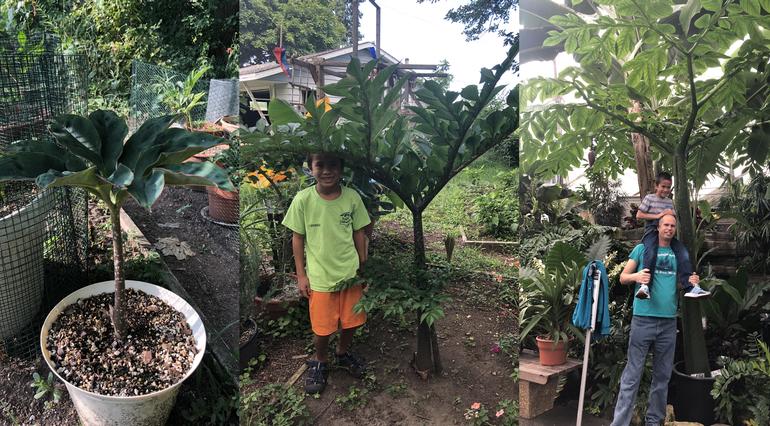Exotic World of Amorphophallus

If you’re looking for an extraordinary plant to add to your collection, Amorphophallus konjac, commonly known as Konjac or Devil's Tongue, might just be the perfect choice. Known for its striking appearance and fascinating growth habits, this tropical plant can be a conversation starter in any garden.
I started growing amorphophallus about 15 years ago when I inherited a couple of bulbs from my dad. As a boy, my older brother wanted a unique plant to grow and he found an amorphophallus konjac plant advertised in one of those mail-order catalogs. He purchased it and enjoyed several years of growing it before he lost interest and when he moved out of the house, our father took over the care. This involved planting them (they send out runners that grow new plants each year so after a few years, you end up with quite a lot of them) and then digging up the bulbs and storing them in the basement for the winter. When my wife and I moved back in with my parents while I was in graduate school the expectation was that we’d leave after I graduated. This didn’t happen, so naturally, my parents moved out. In the process, my dad left the konjac with the house. I was intrigued and a love for these unique plants was born.
There are over 230 species of amorphophallus in the world. They range in size from the giant “titan” (the one that gets all the press) to the tiny “ongsakulii.” Each has a unique leaf and flower (often an unpleasant aroma). I started adding to my collection right away with smaller species such as bulbifer, henryi, and kiusianus. I have about 15 different species right now and keep looking for new plants to add to my collection.
Growing amorphophallus is fun and easy. Here are some tips that will help you on your journey:
Climate: Amorphophallus thrive in warm, humid environments, making it ideal for tropical and subtropical regions. However, with the right care, it can also be grown in temperate climates. Just be sure to protect it from frost (though some can handle a frost).
Soil: This plant prefers well-draining soil. A mix of peat, sand, and perlite is ideal to ensure the roots don’t sit in water. The soil should be slightly acidic to neutral, with a pH of 6.0 to 7.0. I grow mine in the HPCC soil that most of Ebert's Greenhouse plants are grown in.
Light: Bright, indirect light is best. While some can tolerate direct sunlight, too much exposure can scorch the leaves, so find a spot where it gets dappled sunlight or filtered light.
Watering: During its active growing season (spring to summer), keep the soil consistently moist, but avoid waterlogging. In the dormant period (fall to winter), significantly reduce watering and let the soil dry out between waterings. For most of the commonly grown species, it's best to remove them from their pots and store them in a paper bag or an open crate in the basement for the winter.
Temperature: This plant prefers temperatures between 60-85°F (15-29°C). It’s crucial to keep it above 50°F (10°C) during dormancy to prevent damage to the tuber.
Fertilizing: Use a balanced, water-soluble fertilizer every 7-10 days during the growing season to support its rapid growth. During dormancy, stop fertilizing until the plant begins to grow again in the spring.
Repotting: Repot it every 2-3 years during its dormant phase to refresh the soil and accommodate its growing tuber.
Pests and Diseases: While amorophalluses are relatively pest-resistant, you should still monitor for common pests like aphids and spider mites. Overwatering can lead to root rot, so always ensure your plant has proper drainage.
Understanding Dormancy and Flowering
After the growing season, most Amorphophallus naturally enters a dormant phase. The leaves will die back, and the tuber will rest until the next spring. During this time, store the tuber in a cool, dry place to keep it healthy.
One of the most fascinating aspects of amorphophallus is its flower. When mature, the plant produces an exotic bloom (size varies by species) with a unique and (often) potent aroma. While the smell, reminiscent of rotting flesh, can be off-putting to some, it’s all part of the plant’s charm and serves to attract pollinators in its native habitat.
Final Thoughts
Growing Amorphophallus is more than just a plant; it’s an experience. From its impressive foliage to its extraordinary flower, amorophophallus offers something different for the adventurous gardener. With the right care, this exotic plant can thrive and become a highlight in your garden, rewarding you with its unique beauty year after year.
(Pictures: top from left to right: amorphophallus atroviridis, konjac, and titan (at Mitchell Park Domes, Milwaukee, WI). Bottom: Jake, his daughter, and mother with a Titan flower at Olbrich Botanical Gardens in Madison, WI)
